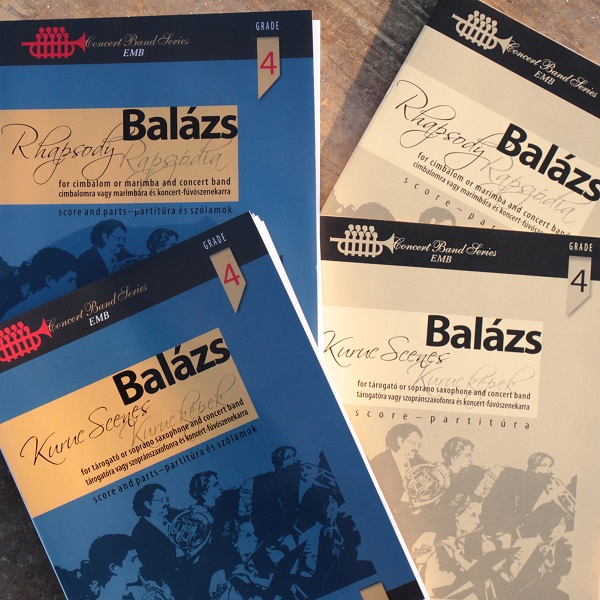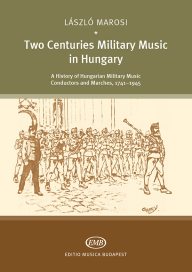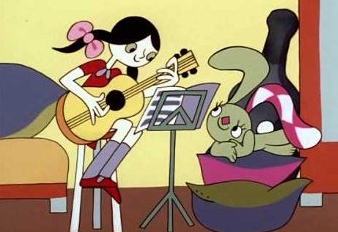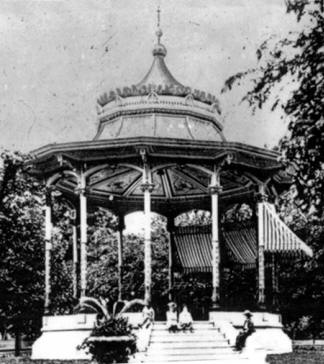Band Music News
Balázs Árpád: Variations on a Theme by Elgar
|
In Árpád Balázs's diverse and varied oeuvre, works for wind orchestra play a prominent role alongside choral music. He composed the Elgar Variations in 2022 on the theme of one of Edward Elgar's (1857-1934) short early works (Love's Greetings, 1888). As Árpád Balázs writes ''The theme I used as the starting point for my work may already be considered a variation, since I 'peeled off' the dense ornamentation and the tonicisations from it, and what remained was the melody, beautiful in its own place. What come back from time to time from the theme in the variations are: the arched structure, the double peak point, and mostly the major sixth leaping downwards, then upwards. The modest, transparent orchestration, which then is amplified at the repetition of the theme is also a defining feature. There is a personal family secret hidden in the third variation: a late compliment to a loyal spouse for the past half century... The closing variation is calm and quiet - similarly to the chorale-like slow movement in Béla Bartók's 3rd Piano Concerto. It is like a message from an old composer to the Future.'' |
Buzzing Polka
|
Buzzing Polka, composed in 1993, is one of the earliest compositions by László Dubrovay (*1943) for concert band, which has become a huge success due to use of special timbres and effects which had been unexploited in the genre earlier. Already the title tells that classical musical values and surprising moments of special brass instrument techniques can be both found in the work. Every second in the striking character piece is made interesting by the excellent balance between the pillar-like harmonies enriched by distant overtones and horizontal melody formation. Performing Buzzing Polka is a great opportunity for conveying the message and values of the music of the 20th and 21st centuries through the contrast between classical melodies and new ways of instrumentation. |
After Mozart
|
László Dubrovay's work, written in 2006, on the 250th anniversary of Mozart's birth, is a salute of a 21st-century composer to one of the greatest geniuses in the history of music. The composer builds his original ideas on one of the best-known melodies of The Marriage of Figaro (Figaro's aria: ''Non pi? andrai, farfallone amoroso''). The series of variations on the theme of the aria is created by the involvement of special instruments, and by fully harnessing their technical abilities, while Dubrovay's hallmark of a perfect balance and peculiar compositional tone is realised on an exceptionally large orchestra. The work is suited to illustrate the potentials of crossovers between different periods in the history of music, but it can also be played at a festive, thematic concert. |
Dubrovay László: Festive Music for symphonic band
|
This work of festive atmosphere was written in 2000 for symphonic band, then the composer arranged it for symphony orchestra. In this piece, László Dubrovay (*1943) parts with his special, hallmark concert band effects; rather, lively vibrations enriched with colliding seconds and distant overtones are brought to the foreground. The special sound is coloured by ornamental trills, appearing even in batches, and vibrating collisions in the high registers. The performance is rendered even more unique by the outer trumpets on both sides of the space. The trumpets and the flugelhorns can be divided into ten parts altogether, thus, the piece can be played by one ensemble or several bands together, as it is usual at the conclusion of large-scale festivals. This composition may be a great choice for festive concerts, since it is a solemn, innovative, and - by virtue of the free arrangement of the performing space - special work at the same time. |
Two new titles by Árpád Balázs have been published
|
Kuruc Scenes The composer uses melodies from the early 18th century, from the age of Rákóczi's war of independence. Rhapsody Rhapsody follows the one-movement structure created by Franz Liszt. The Rhapsody is a passionately emotional lyric orchestral poem rich in colours and characters, which has a place on the repertoire of every concert band playing quality music. Publisherd by Universal Music Publishing Editio Musica Budapest |
Two new titles for concert band

Two new titles by Árpád BALÁZS have been published in the Concert Band series.
Árpád BALÁZS: Kuruc Scenes
for tárogató or soprano saxophone
and concert band
The composer uses melodies from the early 18th century, from the age of Rákóczi's war of independence.
Árpád BALÁZS: Rhapsody
for cimbalom or marimba
and concert band
Rhapsody follows the one-movement structure created by Franz Liszt. The Rhapsody is a passionately emotional lyric orchestral poem rich in colours and characters, which has a place on the repertoire of every concert band playing quality music.
Publisher: Universal Music Publishing Editio Musica Budapest
One full score as well as individual parts are provided for each work.
Ferenc Farkas: Early Hungarian Dances from the 17th century
 The composer wrote of his work as follows:
The composer wrote of his work as follows:
In the music of Hungary, folk songs are manifestly of great importance, on the other hand our ancient airs and dances play a modest role. For this work I have been influenced by dances of the 17th century, written by unknown amateurs in a relatively simple style. Most of these dances were recorded between the 14th and 18th centuries under the usual form of tablature notation. My interest in this music was first captured in the 1940s. I was so fascinated that I decided to give these melodies new life.
Two Centuries Military Music in Hungary

The purpose of this book is to describe the function of military music in the musical life of Hungary in a historical context. With this historical account, it can contribute to the general wind music history revealing the details of band music in that culture. The study analyzes the music of the Hungarian Permanent Army from the early eighteenth century until the middle of the twentieth century. The musical development from the instruments of tunesters is described from the oboists, harmonie, and the seminal appearance of wind band as we know it today. Through the biographical sketches of conductors, descriptions of instruments used in various instrumentations, the role of the uniform unique to each band, and programs of the performed music, the study also describes the function of band music in the cultural life of Hungarian cities during this particular period. This descriptive study is an account of 200 years of Hungarian military music.
László Marosi was born in Sárvár, Hungary. He studied conducting at the Liszt Academy of Music, Budapest, with Tamás Breitner. From 1982 to 1997 he was conductor of the Hungarian Central Army Wind Orchestra and recorded several works by Franz Liszt and contemporary Hungarian composers such as Kamilló Lendvay, Frigyes Hidas, László Dubrovay, Iván Patachich, János Decsényi, István Láng, and György Ránki. He also widely toured with the Orchestra throughout Europe. Besides, he taught conduction at the Teacher Training Faculty of the Liszt Academy, conducted the Academy’s Wind Band, and, from 1993 he became conductor of the professional Budapest Symphonic Band. Between 1989 and 1994, Marosi conducted more than fifty performances annually with the Budapest State Operetta Theater Orchestra. He was invited as a guest conductor by the Matáv Symphony Orchestra in Budapest, and toured Europe with the Strauss Symphony Orchestra in 1996 and 1998.
 Following his professional career in Hungary, he earned a MM in conducting and a PhD in music education at Florida State University with James Croft and Philip Spurgeon. He frequently conducted the University Symphony Orchestra, including acclaimed performances of the music of Ellen Taaffe Zwilich and Shulamit Ran. As Visiting Professor, Dr. Marosi served as Associate Conductor of the FSU Wind Orchestra during the 2002/2003 academic year.
Following his professional career in Hungary, he earned a MM in conducting and a PhD in music education at Florida State University with James Croft and Philip Spurgeon. He frequently conducted the University Symphony Orchestra, including acclaimed performances of the music of Ellen Taaffe Zwilich and Shulamit Ran. As Visiting Professor, Dr. Marosi served as Associate Conductor of the FSU Wind Orchestra during the 2002/2003 academic year.
As guest conductor, lecturer and adjudicator he has appeared throughout Europe, England, Israel, South Africa, Namibia, Argentina, Brazil, Chile, Costa Rica, Honduras, Colombia, Peru, Japan, Kazakhstan, Mexico and in the United States.
For his contributions to Hungarian contemporary music, he was twice awarded the Artisjus prize by the Hungarian Composers’ Union. In 1997 he was awarded the FAME prize for his international conducting activities and won the RIA award for his international research activities at University of Central Florida in 2012.
Just published: Ungaresca by Győrffy
Hungarian or Hungarian-style dance music which flourished in the 16th and17th centuries - generally referred to as ungaresca - represents a valuable part of European musical tradition. István Győrffy’s work with its characteristically Hungarian tone, composed between 2007 and 2010, is a late successor of this tradition.
Music with Chequered Ears
 Television viewers of nearly a hundred countries have experienced Árpád Balázs's touching melodies. The series of cartoons have neither dialogue nor text: the music presents the amiable and entertaining adventures of the rabbit with chequered ears and its friends. Balázs has rephrased and developed the well-known melodies and as a result a ''children's story symphony'' of seven movements has been created in which, in contrast with Prokofiev's Peter and the Wolf, there is no narrator but the instruments themselves represent the story-tellers. The composer has again associated the groups of instruments with one another in a colourful and varied manner, skilfully alternating the modes of solo, chamber orchestra and orchestra. Movements I, II, IV and VII represent a ''short suite'' that can be independently performed, thus due to its duration of four minutes and easier level, ensembles with more modest opportunities can also perform it. The most well-known parts of the cartoon series music - the main title and the ending - are included in both versions.
Television viewers of nearly a hundred countries have experienced Árpád Balázs's touching melodies. The series of cartoons have neither dialogue nor text: the music presents the amiable and entertaining adventures of the rabbit with chequered ears and its friends. Balázs has rephrased and developed the well-known melodies and as a result a ''children's story symphony'' of seven movements has been created in which, in contrast with Prokofiev's Peter and the Wolf, there is no narrator but the instruments themselves represent the story-tellers. The composer has again associated the groups of instruments with one another in a colourful and varied manner, skilfully alternating the modes of solo, chamber orchestra and orchestra. Movements I, II, IV and VII represent a ''short suite'' that can be independently performed, thus due to its duration of four minutes and easier level, ensembles with more modest opportunities can also perform it. The most well-known parts of the cartoon series music - the main title and the ending - are included in both versions.Spring, 2013: Three new pieces
 At the turn of the 19th-20th century every town in Europe and overseas with any pretensions to style created in its centre a promenade, a street or square where people could stroll and meet. At a prominent spot on each promenade a music pavilion was erected, and nowadays nostalgia is causing these to be found again in more and more communities. There in the afternoons military, firemen's and student bands played music by Lehár, Fučik and Sousa. Waltzes, marches and pleasant, bittersweet melodies reminiscent of what are seen as the happy, peaceful days before the First World War and the worldwide Great Depression.
At the turn of the 19th-20th century every town in Europe and overseas with any pretensions to style created in its centre a promenade, a street or square where people could stroll and meet. At a prominent spot on each promenade a music pavilion was erected, and nowadays nostalgia is causing these to be found again in more and more communities. There in the afternoons military, firemen's and student bands played music by Lehár, Fučik and Sousa. Waltzes, marches and pleasant, bittersweet melodies reminiscent of what are seen as the happy, peaceful days before the First World War and the worldwide Great Depression.Hungarian Rondo
The Hungarian Rondo by Árpád Balázs is cheerful, good-humoured music, a finely formed work crafted withgreat professional skill.
Its structure is clear: the double recurrence of the rondo theme results in a five-part form. The two episodes differ in character. The first consists of increasingly densely woven imitations that chase eachother playfully; the second evokes the mood of bagpipe tunes. In the latter, above the melody moving evenly incrotchets in the middle parts a pastel-tinted cloud of woodwind notes floats upwards, while the sound is extended downwards by the deep-toned brass stepping lower by semitones. A brilliant device by the composer! In thecourse of its repeats the rondo theme appears more and more richly garbed; particularly the sparkling semiquavers of the woodwind make it ever more decorative.
The Hungarian Rondo is the kind of music that drives your cares away.
 Deutsch
Deutsch Español
Español Français
Français Magyar
Magyar Polski
Polski Română
Română Slovenský
Slovenský Slovenščina
Slovenščina 中文
中文


























